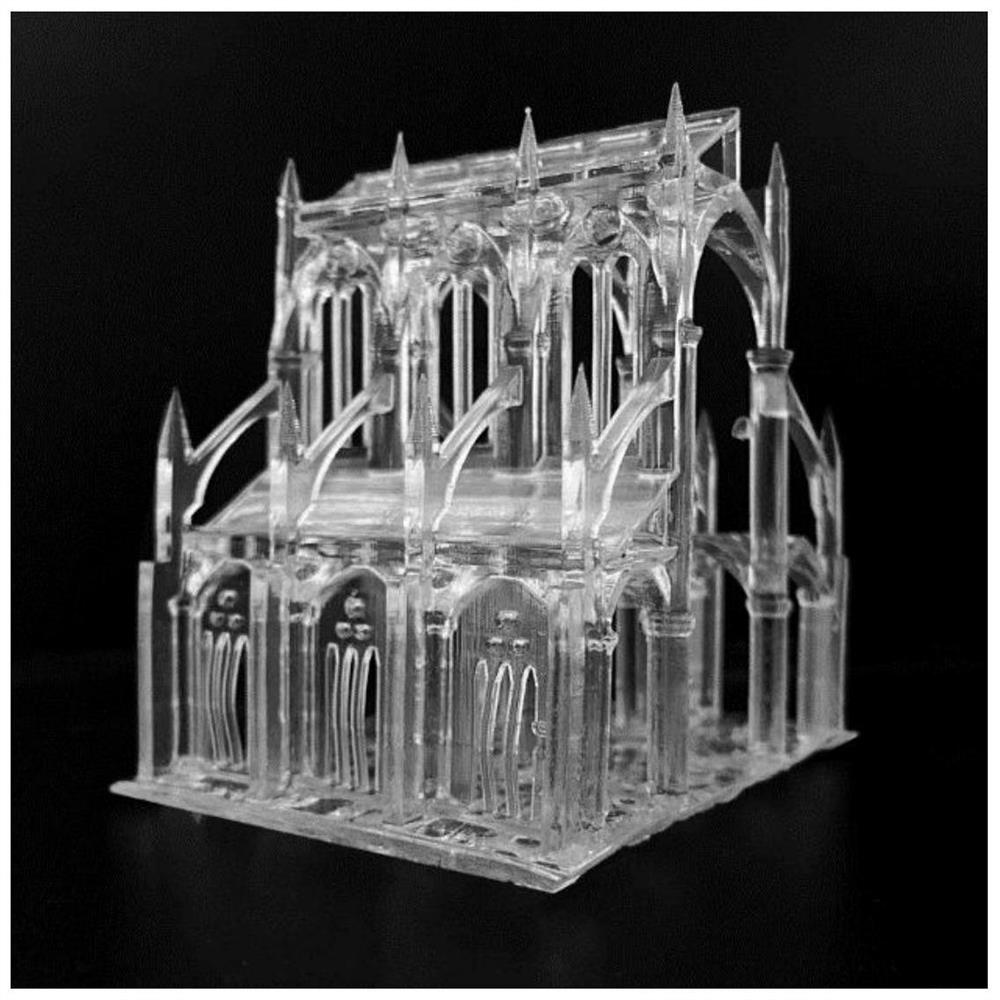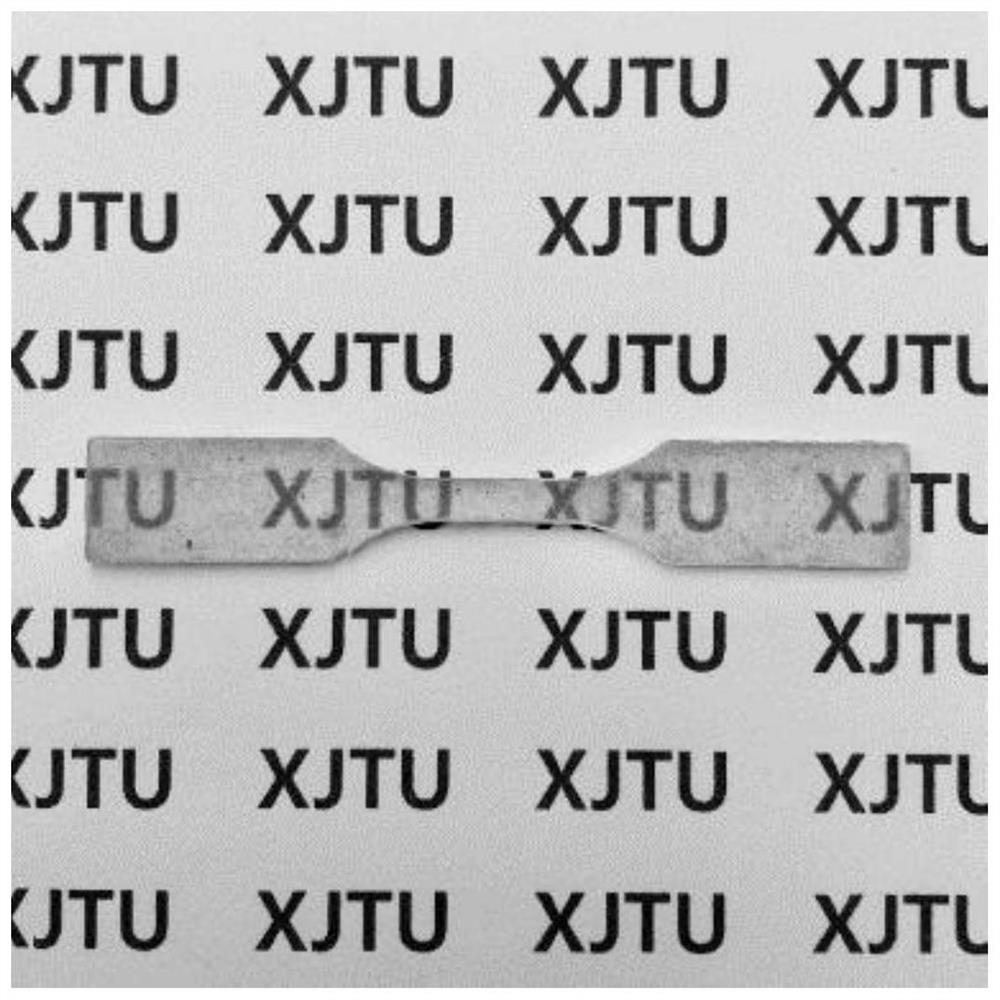A 4D printing photosensitive resin based on dynamic covalent bond and its preparation method
A dynamic covalent bond and photosensitive resin technology, applied in the direction of additive processing, etc., can solve the problems of non-recyclable, low mechanical properties, environmental pollution, etc., achieve 100% atom utilization, excellent mechanical properties, simple and fast preparation process Effect
- Summary
- Abstract
- Description
- Claims
- Application Information
AI Technical Summary
Problems solved by technology
Method used
Image
Examples
Embodiment 1
[0038] In this example, the 4D printing photosensitive resin is a mixture of a reaction product of a dihydric mercaptan and a (meth)acrylate monomer containing an isocyanate group and a photoinitiator, specifically 3,6-dioxa-1,8-octyl Alkedithiol is a dibasic mercaptan, using isocyanoethyl methacrylate as a (meth)acrylate containing isocyanate groups, using N,N-diisopropylethylamine as a catalyst, and using phenyl bis( 2,4,6-Trimethylbenzoyl)phosphine oxide as photoinitiator.
[0039] In this embodiment, a method for preparing a 4D printing photosensitive resin based on a dynamic covalent bond, the specific steps are as follows:
[0040] Add 16g of 3,6-dioxa-1,8-octanedithiol and 0.04g of N,N-diisopropylethylamine to a flask equipped with a shading and stirring bar, mix well, and place on ice Slowly add 28 g of isocyanoethyl methacrylate into the water bath, and react at room temperature for 3 hours. After the reaction, add 0.4g of phenylbis(2,4,6-trimethylbenzoyl)phosphine ox...
Embodiment 2
[0042] In this example, the 4D printing photosensitive resin is a mixture of a reaction product of a dihydric mercaptan and a (meth)acrylate monomer containing an isocyanate group and a photoinitiator, specifically 3,6-dioxa-1,8-octyl Alkanedithiol is a dihydric mercaptan, with isocyanate ethyl acrylate as (meth)acrylate containing isocyanate groups, triethylamine as a catalyst, and phenyl bis(2,4,6-trimethylbenzyl Acyl)phosphine oxides are examples of photoinitiators.
[0043] In this embodiment, a method for preparing a 4D printing photosensitive resin based on a dynamic covalent bond, the specific steps are as follows:
[0044] Add 16g of 3,6-dioxa-1,8-octanedithiol and 0.04g of triethylamine into a darkened flask equipped with a stirring bar. After mixing evenly, slowly add 25g of isocyanate in an ice-water bath Ethyl acrylate, react at room temperature for 1 hour. After the reaction, 0.4g of 2,4,6-trimethylbenzoyldiphenylphosphine oxide was added, and stirred evenly to ...
Embodiment 3
[0046] In this example, the 4D printing photosensitive resin is a mixture of a reaction product of a dihydric thiol and a (meth)acrylate monomer containing an isocyanate group, and a photoinitiator, specifically, 1,6-hexanedithiol is used as the dihydric thiol , with isocyanoethyl methacrylate as (meth)acrylate containing isocyanate group, 1,8-diazabicycloundec-7-ene as catalyst, 1-hydroxy-cyclohexyl- Phenyl phenone is an example of a photoinitiator.
[0047] In this embodiment, a method for preparing a 4D printing photosensitive resin based on a dynamic covalent bond, the specific steps are as follows:
[0048] Add 16g of 1,6-hexanedithiol and 0.04g of 1,8-diazabicycloundec-7-ene into a light-shielded flask equipped with a stirring bar, mix well, and slowly Add 28 g of isocyanoethyl methacrylate and react at room temperature for 2 hours. After the reaction, add 0.4g of 1-hydroxy-cyclohexyl-phenyl ketone, stir evenly to obtain a remodelable and recyclable 4D printing photose...
PUM
| Property | Measurement | Unit |
|---|---|---|
| tensile strength | aaaaa | aaaaa |
| elongation at break | aaaaa | aaaaa |
Abstract
Description
Claims
Application Information
 Login to View More
Login to View More - R&D
- Intellectual Property
- Life Sciences
- Materials
- Tech Scout
- Unparalleled Data Quality
- Higher Quality Content
- 60% Fewer Hallucinations
Browse by: Latest US Patents, China's latest patents, Technical Efficacy Thesaurus, Application Domain, Technology Topic, Popular Technical Reports.
© 2025 PatSnap. All rights reserved.Legal|Privacy policy|Modern Slavery Act Transparency Statement|Sitemap|About US| Contact US: help@patsnap.com



